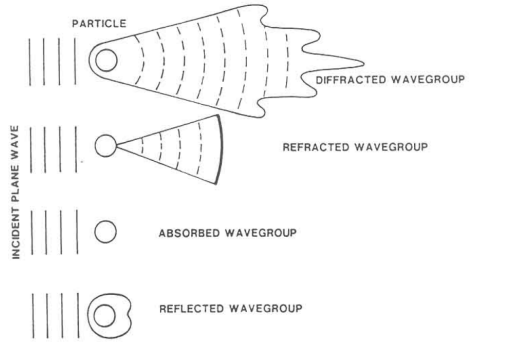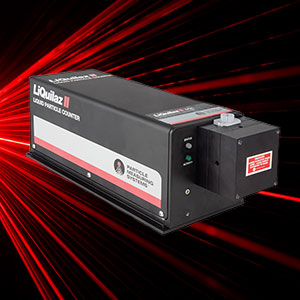
The only optical techniques suitable for continuous monitoring of dispersed microcontaminants are single particle methods embodying imaging, light scattering, or light extinction. Ensemble optical techniques (where more than one particle is observed simultaneously and particle size information is measured from bulk scattering characteristics) are unsuitable. The reason that ensemble methods are not applicable to microcontamination measurements is quite simple: In these applications, the probability of more than one particle being present in an illuminated field is vanishingly small. Ensemble methods are applicable to particle products in the form of slurries or suspensions but not to dispersed particle populations observed individually as rare events.
Automated sizing of microcontaminants is most often accomplished using light scattering or extinction. Extinction is enhanced by absorption. For automatic monitoring, an imaging system is useful in defining a particle’s position but not an effective sizing tool. Scattering is the removal of light from a beam via reflection, refraction, and diffraction. An extinction process is the inverse of scattering where one monitors the transmitted beam and measures the light lost. Extinction and scattering are equal in the absence of absorption.
Semiconductor firms have developed world class clean rooms capable of removing particulates by factors of a million, and thus today’s manufacturing airspace is not the primary source of microcontamination. The emphasis has switched to the process fluids (especially gases, deionized water, wet chemicals, etc.), and the various manufacturing apparatus and processes as being the more likely yield limiting contamination sources.
Instruments utilized to measure microcontaminants in these media must rely upon light scattering methods to obtain submicron sensitivity with useful sampling rates. Laser light sources are invariably used. He-Ne is the most popular laser although argon ion and solid state sources are also used.
For assessing the quality of parenteral drugs, particle sizes of interest begin at approximately 2 µm. Much like in hydraulic applications, users prefer extinction measurements due to the reduced uncertainty to unknown particle shape, refractive index, and enhanced size resolution. It is well known that the amount of scattering or extinction by a particle is a function of its size, refractive index, and the wavelength of light being utilized. Theory also reveals that the refractive index of the medium suspending the particle can be equally important. Since most particle sizing instruments are calibrated via a fixed size versus signal relationship, the response variations with varying media index is a complicating factor increasing the uncertainty of any measurement.
Fundamentally, for homogeneous media the relevant factors determining the amount of extinction or scattering by a small particle are the ratio of the refractive index of the particle to that of the suspending medium and the wavelength of illumination. Historically, the index ratio is referred to as the relative refractive index, but it is more descriptive to adopt the terminology index contrast. Since air and all gases have refractive indices close to unity, the index contrast for aerosol is essentially equal to the particle’s refractive index. However, liquids generally have refractive indices between 1.3 and 1.5 which are much closer to that of most solids (potential liquid contaminants) resulting in much lower index contrasts – even less than unity for some liquid suspended solid contaminants. The interplay of refractive index contrast and particle size analysis in liquids will be explored rigorously in the first section of this article with the aid of Mie theory. In another paper, the importance of refractive index on light scattering measurements was emphasized.
This current work describes the results from a study of refractive index influences on extinction measurements; however, we will draw comparisons to light scattering measurements whenever useful.
Interested in learning more? Complete the form on this page to receive a free copy of the RI Effects on Particle Size Measurement in Liquid application note.









